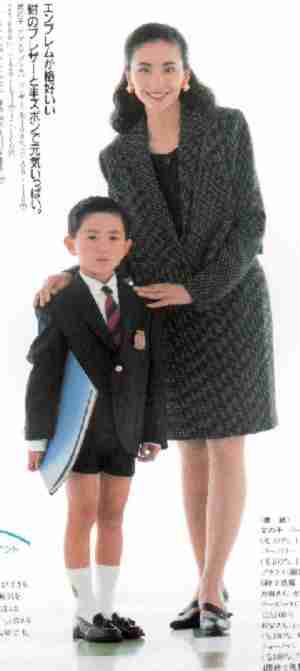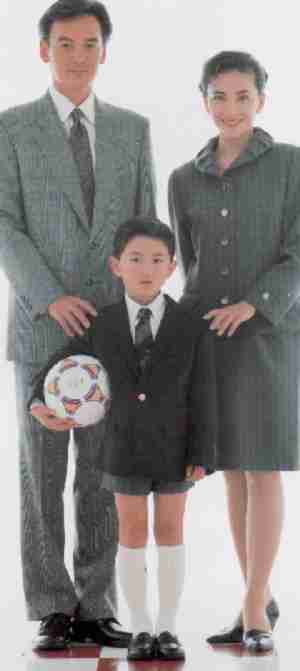
Figure 1.--This was one of the boys' suits recommened by a department store for an all-imprtant school interview. Almost all department stores recommend short pants suits.
Japanese department store catalogs, like those from other countries,
provide many useful details about popular boys' fashions. Unlike
fashion magazines, the department store catalogs provide information
on fashions often selling. The fashion magazines sometimes provide more
fanciful information about fashions that designers and mothers would like
for their boys rather than what was actually worn.
It is critical in Japan for even elementary-age school children to get
into the right school, as explained on the main Japanese department store school dress
page. Department stores attempting to take advantage of the need for parents
to create a good impression hold fairs to assist parents in selecting the
appropriate fashions. This does not mean just the child's
clothes. The parents need to carefully consider the clothes worn
by the entire family. Many department stores participate in the '
fairs showcasing boys, girls, and adult fashions. Fashions show here are from a pammflet distributed at a Tokyo fair.
It is entitled Famous Private and National Elementary School Entrance Interview Fair (1990-91) . The pamflet
shows one key piece of advise for parents. Their son should wear a
conservative short pants suit or blazer and shorts to the interview. Most
advisors tell parents that it would be a serious mistake to bring their
son to the interview in long pants.

Figure 1.--This was one of the boys' suits recommened by a department store for an all-imprtant school interview. Almost all department stores recommend short pants suits. |
Some aspects of the fashions recommended by this department store
are:
Suit: The recommended suits are are very conservative navy
blue or grey wool suits. The material is a blended fabric with
5 percent rayon added.
Blazer: A smart blazer in lieu of a suit is also acceptable.
Like the suits they should be a conservative color, usually navy blue.
Shirt: The store strongly recommends a conservative white
dress shirt.
Tie: The boys should certainly wear ties to the interview.
Conservative stripped ties are recommended.
Short pants: The store only shows short pants to be worn with
the suit coats and blazers. The shorts are cut rather short with only
1-2 inches showing under the coat or blazer. The shorts for the blazer
can be navy blue, grey, or a very muted plaid. The material again is
a blended fabric, mostly wool, but 5 percent naylon added.
Socks: The pamphlet shows that both kneesocks and ankle socks
can be worn for the interview. The department store only shows white socks. Dark socks are also commonly
worn at Japanese schools. I am not sure if the department store is
suggesting that only white socks should be worn.
Shoes: Elementary children commonly wear white sneakers. The
boys for the interview, however, are stronly advised to wear
conservative black leather shoes, of course very carefully polished.
Polo and Absuabusoruba are the manufacturers. Polo is the Ralph Lauren line; they cater to Japanese tastes. The other one I've never heard of. Centimeters refer to height. Boys clothes in Japan are typically sold by
the height of the boy, not the age. Generally the tallest before switching into
young adult is 160 cm (although school short pants are made for even taller boys -- there is the occasional sixth grader who shoots way
up in height -- he still is required to wear the uniformed short pants in schools that have uniforms.).
The pamflet reads, "The Emblem is stylish. The Navy Blazer and Short Pants are Full of
Energy" In small letters: "The boy's ensemble: Absuabusoruba blazer (100% wool)
28,000 yen (100-110 centimeters); 120-130 cm, 30,000 yen. Absuabusoruba
short pants, (100% wool) (100-110 cm, 7,500 yen, 120-130 cm, 8,000 yen. Sixth
floor,children's clothes. Absuabusoruba button down shirt, (100% cotton), 100-110cm, 5,300 yen, 120-30 cm., 5,800 yen."

Figure 2.--This was one of the boys' suits recommened by a department store for an all-imprtant school interview. Almost all department stores recommend short pants suits. |
An inner page is headed " Q&A: How to build confidence for the interview."
What are the clothing checkpoints for the interview?
Answer The interview will probably last around ten minutes. During
that time, (the child will need) to make his or her appeal in several ways.
Since the time is short, it's hard to say what is most important. Points
include the greeting, the posture, and the use of words, and of course, the
neatness and charm of (the child's) style."
Then there are seperate dress suggestion boxes for boys and for girls. The boy's box is illustrated with
three pairs of short pants ( gray, navy, and plaid not modelled) by Miki
House , a major Japnaese manufacturer of children's clothes, with price and size
info. The box reads as follows for boys: Checkpoints. Jacket. Solid color. First choice navy, then gray.
In the main, blazers without an excessively loud chest emblem or too many
buttons are the best received. Pants. Should be short pants. Color can
be navy or gray. Shirt. White long-sleeved button down shirts are the
most popular. Traditional style makes a good impression. Necktie. Orthodox regimental stripes suggest a little gentleman. Socks. White or a subdued solid color. Knee Socks are also fine." [Note that to the Japnese "blazer"(they use a phonetic transcription of the English word) does not mean the brightly colored jacket of British schoolboys but only a jacket that is not worn with matching trousers -- in other words a formal jacket but not a suit jacket. A navy jacket, for example, to be worn with gray trousers, would
in Japan be typically called a blazer.
What's the best style (of clothes) for the P.E. test?
Answer: In the P.E. test, to look a model of action, (the child) should
demonstrate ability and energy in doing the indicated exercises. Plain
white short sleeved polo shirts, a plain navy sweatshirt or vest permit
easy movement and create a bright impression. Boys' short pants should be
grey or navy. Plain navy skirts are likewise best recevied for girls."
This is illustrated with two long sleeved and one short sleeved white polo
shirts, not modelled.
HBC note: Japanese parents would understand that the
vest would be mostly for girls. In many uniformed schools, boys do not
have a separate pair of P.E. shorts. When they do, they are almosdt always white.
The boys just take off their jackets in the winter or change their shirts in the
summer. One of the original reasons for the widespread adoption of short
pants for boys decades ago was that it obviated the necessity of buying
something separate for P.E.
There's a third question, but it refers to the image the parents
should attempt to project.
The pamphlet came out in 1992. I would guess that today much of
the advise would be the same, but the short pants would be considerably longer,
cuffed, and reaching to just above the knee. In recent years (beginning about 3 or 4
years ago), the length of formal shorts begun to be longer (just above
the knee). There are in 1999 no short shorts (for formal use) in virtually any
Japanese department stores.
Navigate the Boys' Historical Clothing Web Site:
[Introduction]
[Chronology]
[Clothing styles]
[Biographies]
[Bibliographies]
[Contributions]
[Countries]
[Boys' Clothing Home]
Navigate the Boys' Historical Clothing Japanese pages:
[Return to the Main Japanese department store page]
[Return to the Main Japanese page]
[Japanese school uniforms]
[Japanese choirs]
[Japanese monarchy]
[Japanese Scouts]
[Japanese recitals]